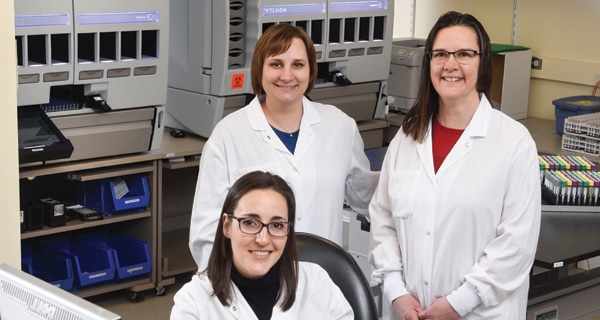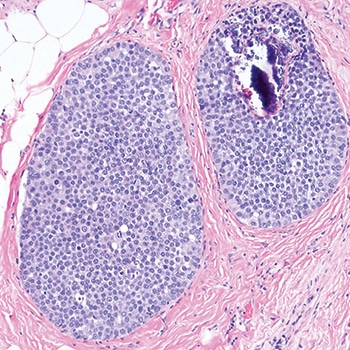December 2020—By its very nature, the global pandemic has forced laboratories to look far and wide, to bring binoculars, in essence, to their views of supply chains, testing platforms, personnel, and the like. As COVID-19 churns on, some labs are looking through a tinier lens as well. These labs aren’t trading their binoculars for a jeweler’s loupe, exactly, but they have found small and significant success stories closer to home. Like so many others, Erin Graf, PhD, D(ABMM), has confronted a spinning roulette wheel since the pandemic’s start. In a talk she gave in an AMP webinar in October, Dr. Graf posted a vibrantly colored wheel titled, “Which supply chain issue will impact us this week?” Each segment contained a phrase familiar to everyone in 2020, ranging from “swabs” and “sheep blood agar” to “pipette tips” and “chlamydia and gonorrhea tests.” As she surveys these continuous claims on her attention, Dr. Graf says, “I think none of us could have ever thought that COVID would have an impact on all these arms of the testing that we do.”
Read More »Thyroid during pregnancy: how it changes, how to test
October 2018—How pregnancy affects normal thyroid function and thyroid function tests, and screening for thyroid disease during pregnancy, were the focus of a session at this year’s AACC annual meeting.
Read More »TB testing: new approaches to old scourge
April 2018—Scratch the surface of TB testing, and things quickly get interesting. The standard skin reaction test, widely adopted by the early 1940s, is still in use today. The goal has remained steady as well: break the transmission cycle. “From the clinician perspective and the laboratory perspective, because of its infectious nature, we want to identify people with latent tuberculosis,” says Elitza Theel, PhD, lab director for the infectious disease serology laboratory, Mayo Clinic and Mayo Medical Laboratories.
Read More »HBsAg tests, mutation in public health spotlight
April 2018—If you were asked to pick a place on the map where problems with detecting a mutant strain of an infectious disease would likely come to light, the capital of Nebraska might not be your first guess.
Read More »Fewer false-positive pregnancy results with intact hCG
April 2018—When women of childbearing age check in at a cancer center where they might be undergoing medical or surgical treatment, the screening protocol is often to test them for pregnancy, primarily by quantifying serum β-hCG.
Read More »LCIS variants and DCIS: tips on telling them apart
April 2018—DCIS or LCIS? Making the distinction can be difficult in some cases. Stuart J. Schnitt, MD, in a session at CAP17 on ancillary testing in breast pathology, delineated the reasons and provided tips, including the role of E-cadherin immunostains to help in this distinction. The cells of DCIS typically show strong membrane staining for E-cadherin while the cells of LCIS are typically E-cadherin negative. But among the tips: If an in situ lesion is E-cadherin positive, it doesn’t automatically mean it’s ductal carcinoma in situ. As he demonstrated in several cases, the lesion could be lobular carcinoma in situ with aberrant E-cadherin immunostaining.
Read More »In cervical disease dx, agreement rises with p16 IHC use
April 2018—In analyzing cervical tissue, adjunctive use of p16 IHC with H&E-stained slides improves accuracy and sensitivity, according to the results of the Cervical Tissue Adjunctive Analysis study presented by Thomas C. Wright Jr., MD, in a webinar hosted by CAP TODAY and made possible by an educational grant from Roche Diagnostics.
Read More »Hopes, fears as users switch to new troponin
December 2017—The questions that arise over the use of highly sensitive cardiac troponin are as riveting as, if less historically fraught than, the Jefferson-Hamilton debates over the shape of their newborn country. Who should lead—the states or a strong central government? Cardiologists or the emergency department? What cutoffs represent the right balance between admissions, referrals, and sending patients home? And will Lin-Manuel Miranda ever write a smash musical about this cardiac assay?
Read More »Next-gen troponin: out of the gate, into labs
November 2017—The story of highly sensitive cardiac troponin, as written by Dr. Seuss, would provide a small twist. In this version, the Grinch doesn’t steal Christmas. Rather, he keeps delaying it, quarter after quarter, year after year. “I remember maybe seven years ago, Roche told me their assay was coming. It’s coming, it’s coming, it’s coming,” laughs Sihe Wang, PhD, medical director and section head, clinical biochemistry, Cleveland Clinic, and clinical chemistry professor, Cleveland State University.
Read More »Advanced parameters offer faster, surer guidance to cancer care
September 2017—After a career spent studying malignancies in the bone marrow and monitoring the effects of chemotherapy on the bone marrow and neoplastic cells contained therein, Cheryl Hirsch-Ginsberg, MD, stepped out from the bone marrow realm and into the faster-paced world of high-volume hematology.
Read More »Hemophilia diagnosis: how to test, what to know
March 2017—True, hemophilia is no longer commonly known as the “royal disease” (as it was when several generations of European rulers suffered from it). But in a January webinar, Dorothy M. Adcock, MD, gave some royally important suggestions regarding the laboratory diagnosis of hemophilia A and B.
Read More »HbA1c in CVD treatment: farewell to one size fits all
March 2017—Anchor. Central pillar. Cornerstone. It would be hard to find a weighty synonym for “linchpin” that hasn’t been used to describe HbA1c’s role in diabetes diagnosis and management since 2010, when the assay was recognized by key standard-setting organizations as the equal of fasting glucose and oral glucose tolerance testing in diabetes and prediabetes testing.
Read More »Latest TB testing guide set forth by ATS, CDC, IDSA
March 2017—Testing for latent Mycobacterium tuberculosis infection and active tuberculosis disease remained relatively unchanged for many years. Screening for latent infection depended on an initial positive tuberculin skin test, and evidence for active TB required a positive culture for M. tuberculosis complex. New tests altered this picture in the past five years. For diagnosis of latent infection, interferon-gamma release assays have taken a major role. And nucleic acid amplification testing is becoming a mainstay for establishing a diagnosis of TB.
Read More »One bug or prix fixe? Respiratory pathogen testers weigh in
February 2017—With the number of rapid, accurate molecular assays for respiratory pathogens growing, microbiology laboratories have more options than ever. They include, among others, Meridian Bioscience’s Illumigene assays for group A Streptococcus and pertussis and its newest assay, Mycoplasma Direct, as well as Alere’s assays for influenza A/B, respiratory syncytial virus, and Streptococcus on its i molecular platform. No longer are laboratories limited to inaccurate rapid antigen tests, weeks-long culture, or multi-pathogen panels.
Read More »Buzz, prospects build for heparin-induced thrombocytopenia test
January 2017—U.S. physicians and laboratories are anticipating the early 2017 launch of the HemosIL HIT-Ab(PF4-H) assay, which detects antibodies associated with heparin-induced thrombocytopenia. The new test from Instrumentation Laboratory, Bedford, Mass., is the first fully automated, on-demand assay for HIT.
Read More »With metagenomic sequencing, no pathogen can hide
January 2017—Detecting pathogenic organisms with PCR has become a staple of the clinical microbiology laboratory, so much so that it seems like it has always been there. A more advanced molecular technique—unbiased metagenomic next-generation sequencing—will increasingly become a part of infectious disease diagnosis because it has several advantages over PCR. While it will be demanding to perform at first, it, too, may become a standard method in the clinical microbiology laboratory.
Read More »Procalcitonin passes automation hurdle
December 2016—Matt Damon in Interstellar. Julia Roberts in The Player. Gene Hackman in Young Frankenstein. When movie stars appear in uncredited parts, it’s usually for a cameo, not a leading role. But in diagnostics, an uncredited or off-label use of an assay might be its main use—possibly even its most clinically important use.
Read More »Up next for MALDI-TOF mass spec: AFB, molds
November 2016—Behold the humble API strip, made of plastic, with multiple miniature test chambers, interpreted with the aid of a color chart, and long a mainstay of microbiology laboratories.
Read More »Epi proColon fires up hopes of capturing screening dodgers
November 2016—When a Hollywood producer forecasts box office receipts, or a public health official contemplates action against a deadly but preventable cancer, there’s one hypothetical that might make both shudder: What if you held a screening and nobody came?
Read More »Labs enter a MALDI-TOF state of mind
October 2016—When MALDI-TOF mass spectrometry enters the microbiology lab, it’s a little like watching Sir John Falstaff settle his considerable girth onstage. Things happen. Characters fret and flee, scheme, opine, panic, and, in the case of Prince Hal, ascend to greatness. (And, if we’re honest, some just get drunk.) Both, in brief, are an upending presence.
Read More »Yale researchers dig for new kidney biomarkers
October 2016—An automated immunoassay has been created for symmetric dimethylarginine, or SDMA, a biomarker that can detect chronic kidney disease between 10 to 17 months earlier than creatinine, with 100 percent sensitivity and 91 percent specificity. And, unlike with creatinine, a patient’s muscle mass does not influence the biomarker’s reliability.
Read More »Beauty fad’s ugly downside: test interference
September 2016—It’s the kind of health promotion advice one might pick up casually over lunch with friends, in a quick Google search, or during a visit to the hairdresser. Take megadoses of an over-the-counter vitamin called biotin—a common supplement in multivitamin compounds—and watch your skin improve and your hair and nails thicken and gleam. In recent years, online social networks and health-related websites have begun to teem with ads claiming that people have seen a transformation since they jumped on the biotin bandwagon.
Read More »Mass spec up front for pain management testing: Interest growing in oral fluid testing as alternative to urine testing
September 2016—This fall, Brigham and Women’s Hospital, Boston, is taking the mass spec leap. A plucky PR person might be tempted to refer to it as MassSpec LEAP!™ but Stacy Melanson, MD, PhD, doesn’t have time for such nonsense. As the associate director of clinical laboratories and co-director of chemistry, Dr. Melanson has more important matters to attend to. She and her colleagues are shifting from using a screening immunoassay for pain management drug testing to up-front definitive testing by LC tandem mass spectrometry.
Read More »Poisoning, overdose: Better technology, workflow improve patient odds
July 2016—As pronouncements by fictional detectives go, one of the most famous is Sherlock Holmes’ declaration to Dr. Watson: “When you have excluded the impossible, whatever remains, however improbable, must be the truth.” Unfortunately, Holmes’ advice is no practical rule of thumb for solving the real-world mysteries of patient poisoning or overdose, because the possibilities are often so vast.
Read More »Early days, early detection, early treatment for HIV
May 2016—In 1985, when the first test for HIV—then called human T-cell lymphotropic virus type III—became available, it was approved for screening blood products but not for diagnostic use. A diagnostic test for antibody to HIV-1 was soon approved. Over the subsequent 30-plus years, further iterations of HIV screening tests have been made, with increasing sensitivity and specificity and a shorter window to detection. Fifth-generation tests are now under review. CAP TODAY asked Eileen Burd, PhD, D(ABMM), to discuss the evolution of HIV diagnostics and algorithms for using them and to give a qualitative evaluation of the pending fifth-generation assay.
Read More »With high-sensitivity troponins, watching and waiting continue
May 2016—Laboratories and hospitals in the U.S. continue to look forward to high-sensitivity troponin assays. Judd E. Hollander, MD, says all he’s heard for the past five years is that an assay will be out at the end of the year. “And once you get halfway through the year, it will be out next year,” says Dr. Hollander, chair of the Department of Emergency Medicine and associate dean of strategic health initiatives at Sidney Kimmel Medical College of Thomas Jefferson University.
Read More »FilmArray ME panel—clinical trial to 1st clinical test
May 2016—The BioFire FilmArray meningitis/encephalitis (ME) panel received FDA clearance last October, and in November Jennifer Dien Bard, PhD, D(ABMM), of Children’s Hospital Los Angeles, presented the results of the multicenter clinical evaluation of the panel, in a webinar produced by CAP TODAY in collaboration with BioFire. The panel’s use in the clinical setting will reduce turnaround time and may, pending further studies, have a positive impact on patient care and outcomes, said Dr. Dien Bard, director of the clinical microbiology and virology laboratories at Children’s Hospital LA.
Read More » CAP TODAY Pathology/Laboratory Medicine/Laboratory Management
CAP TODAY Pathology/Laboratory Medicine/Laboratory Management
























